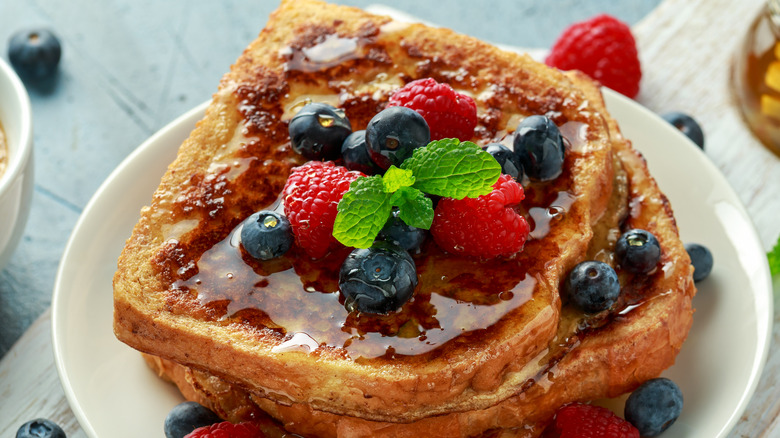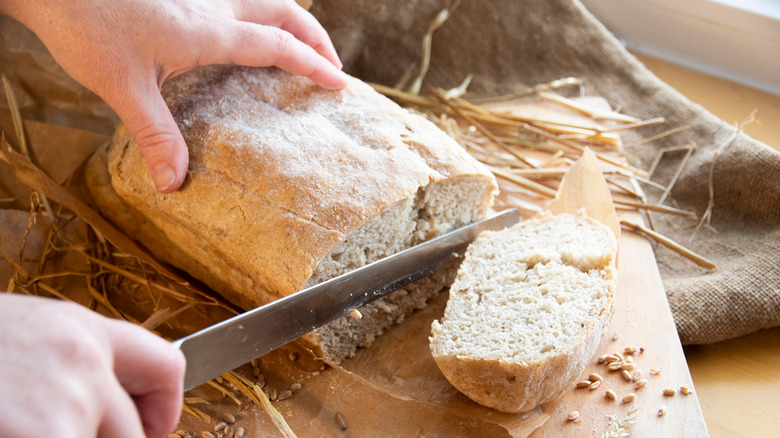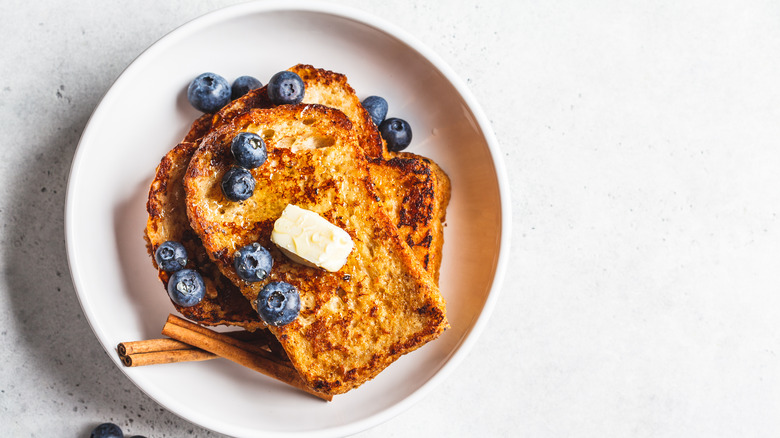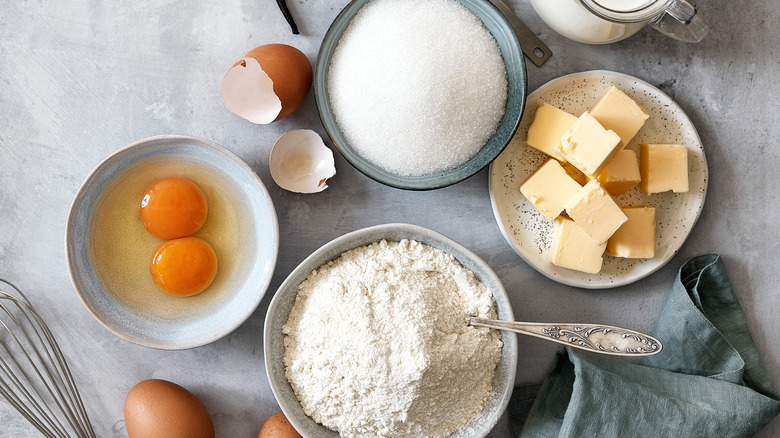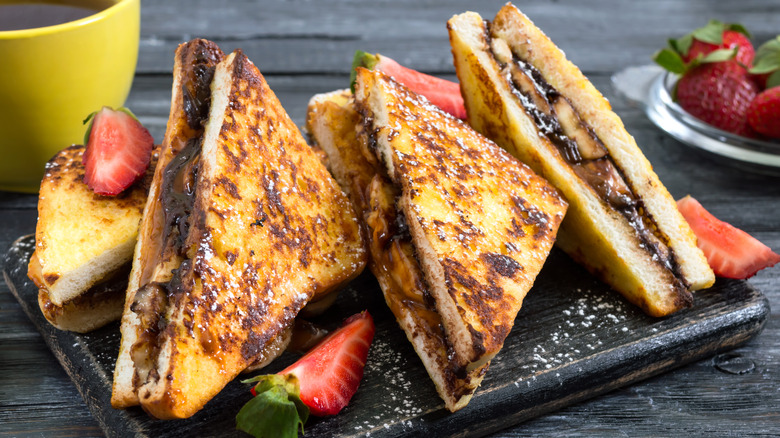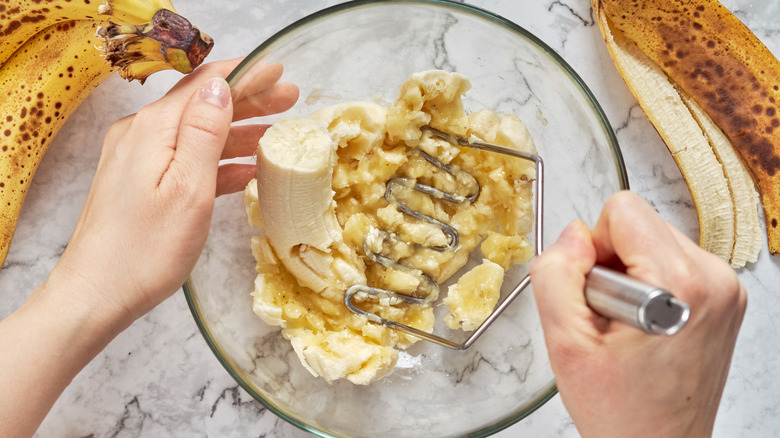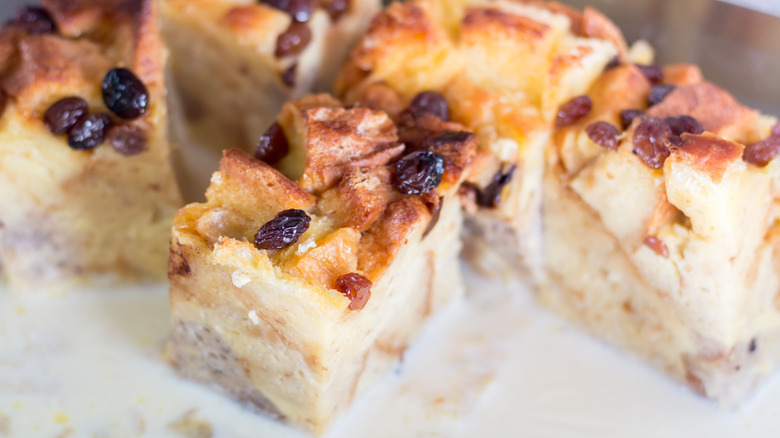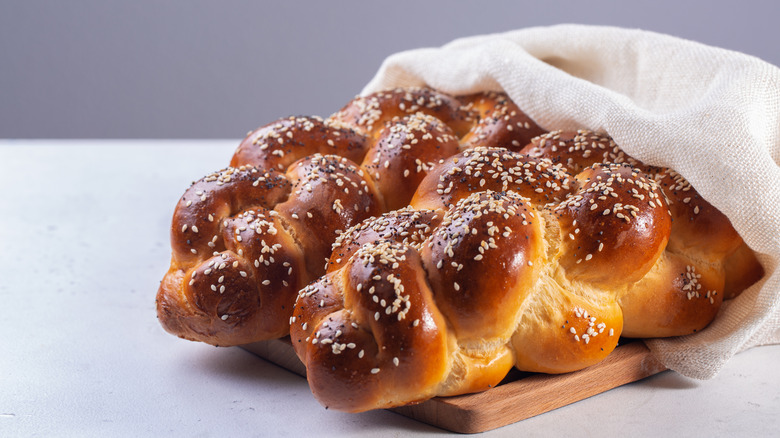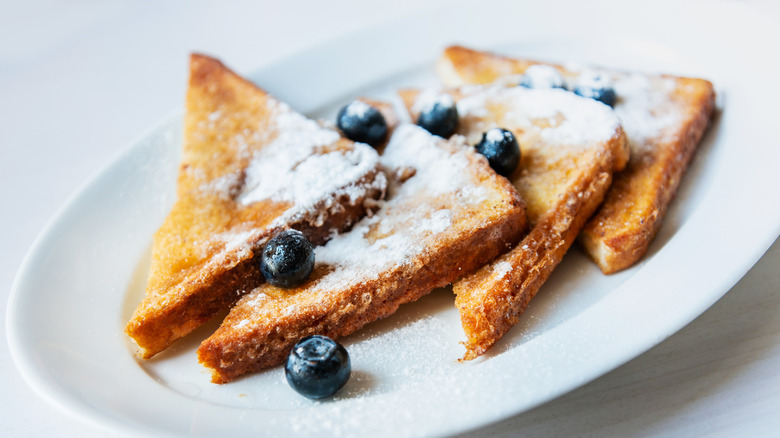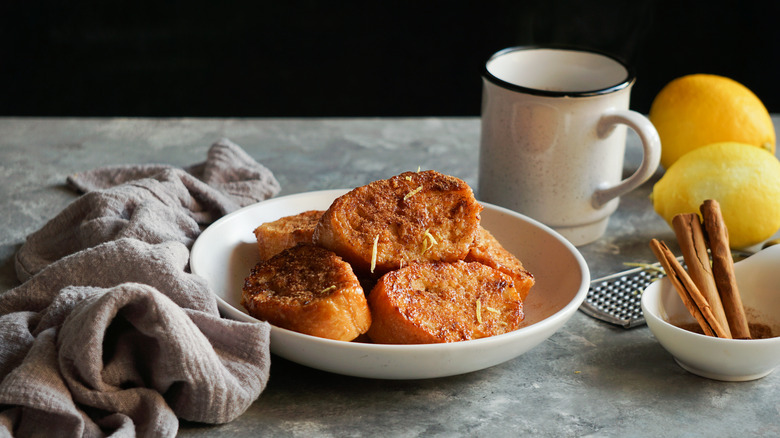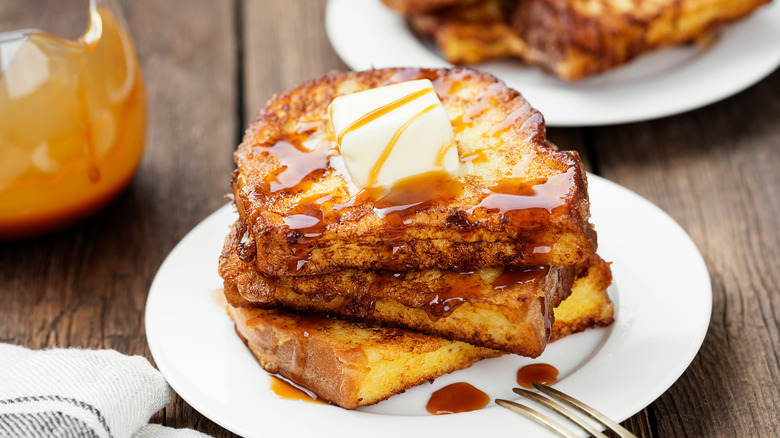The Untold Truth Of French Toast
French toast holds a special place in many of our hearts. It's a quick and easy breakfast requiring simple ingredients and no exact measurements. Many of us know it as a childhood breakfast that often came in the form of sticks to dunk in maple-flavored corn syrup. Now, the dish has taken on a resurgence as a bougie brunch food.
With roots in ancient Rome, medieval Europe, and South America, French toast gets around and has been well regarded for thousands of years. It is one of the rare foods that was known as a peasant food and an affluent meal at the same time, according to Food and Wine.
French toast may not be French, but it certainly is delicious and comes with more interesting facts than it has toppings. If you want to learn more about how French toast came to be and why we call it French, we have you covered. Here is the untold truth of French toast.
French toast dates back to imperial Rome
French toast dates back to the first century of ancient Rome. A recipe for what we now call French toast appears in a Latin language cookbook called Apicius de re Coquinaria. The recipe is called aliter dulcia, which translates to "another sweet dish." This does not help distinguish it from the other recipes in the section though, as there are a total of four recipes also called aliter dulcia. Recipe 296 is the one that we would now think of as French toast. Unlike today, when we tend to think of French toast as breakfast, it is listed as a "home-made sweet."
References to what we now know as French toast continue to show up throughout European history. As early as the 14th century, Germans have a record of arme ritter or "poor knights bread," per Food and Wine. In the Middle Ages of Europe, the French royal cook Taillevent wrote a cookbook, Le Viandier, which included a recipe for "golden bread." These recipes all have different names, but are all early versions of the breakfast food we know and love.
It has practical applications
With a recipe this old, it's no wonder that it was created with a practical purpose in mind. Although bread from a grocery store today can last days, if not weeks, without getting stale and inedible, this was not always the case. Preservatives were not readily available throughout history, per SmartBreadMaker.
Additionally, white bread was the preferred choice of bread in medieval times, as it was thought to be healthier. This led to a conundrum, though — with all of the efforts that went into creating bread, no one wanted to waste it. However, white bread went stale so quickly that something had to be done to make stale bread edible. Enter French toast. The stale bread was soaked in egg and milk, then fried in order to soften it up and make it chewable again. The frying would then cook the egg, and voila — a waste-free recipe is invented.
Luckily, we don't have to worry about waste as much today because our bread lasts longer. That being said, most of us don't eat through a whole loaf of bread in a day, so when you find yourself with some extra and want to use it up, why not make some French toast?
The French don't call it French toast
Much like how the French don't use the phrase, "French fries," and just call them pommes frites (potato fries), they also don't call the dish we're discussing today French toast. Unlike French fries, the French name for French toast doesn't bear any resemblance to the English name.
Funnily enough, the French originally called the bread pain à la romaine, or "Roman toast." This was in reference to the recipe's Roman origin. Now, however, the French call it pain perdu which translates to "lost bread." This is in reference to the origins of the dish as a way to save stale or lost bread from going to waste by repurposing it.
It is thought that the term "French toast" started in the 17th century in England and was then carried to the United States by early colonizers. This then led to the term's popularity in America, where the term "French toast" is still used today to describe the dish.
It was not named for Joseph French
There is another popular legend of how French toast got its name, and that is the story of Joseph French. According to the story as detailed by Food and Wine, in 1724, there was an American chef named Joseph French. French created French toast, and when it came time to market his creation, he named it after himself. Either not knowing enough grammar or not caring about it, he decided to call the dish "French toast" instead of the possessive "French's toast." In some versions of the story, Joseph French is an innkeeper in Albany, N.Y., instead of a chef, according to Slate.
This story has largely been dismissed as a myth in recent times for a number of reasons. For starters, we know that French toast existed before 1724. There were also references to the term "French toast" in England in the 17th century before it made it to the colonies — and before the supposed Joseph French would have existed. While it is a fun etymological story, it is, sadly, false.
French toast is made from three simple ingredients
The original recipe from Apicius calls for plain white bread to be broken, which means to be sliced, and to have the crust removed before being soaked in milk and eggs. Afterward, the soaked bread is then fried. The recipe is simple but effective. With no measurements given, one could likely recreate it in their kitchen with very little trouble. To finish it off, the recipe recommends topping with honey before serving. While maple syrup is a common topping in North America, perhaps we should take a leaf out of the ancient Roman book and try it with honey.
Modern-day recipes are incredibly similar. Jamie Oliver, for example, recommends two eggs, and "a splash" of milk as his base. He includes the additions of vanilla and cinnamon, as well as some other recommendations for flavors. At its base, though, the recipe is simple: bread, milk, and eggs that are lightly fried. It is not fussy or delicate and is an easy enough recipe for most people to follow.
It is endlessly customizable
Partly thanks to its simple base of eggs, milk, and bread, French toast is endlessly customizable. The base can be augmented with spices or extracts to flavor the toast itself. The finished toast can be topped with berries or yogurt, instead of or in addition to maple syrup (real or corn-syrup based) or honey. It can also be stuffed with cream cheese for an ooey-gooey center. For the more ambitious, there are intensive recipes, such as this Wine Country French Toast, which features spices, fresh rosemary, and wine, and Cardamom Saffron French Toast, which adds brown sugar, rose water, and cardamom. Instead of being fried on the stovetop, it is baked in the oven.
French toast doesn't even have to be a sweet dish. As there is no added sugar in the basic recipe, French toast can fit your sweet and savory culinary needs. For savory French toast, Jamie Oliver recommends mushrooms and avocado as a topping. Pepper can be added to the egg and milk wash to bump up the flavor before being served with ketchup, brown sauce, or sriracha in place of the sweet toppings of maple syrup or powdered sugar. With French toast, you are really only limited by your imagination.
Vegan versions are made with bananas
It might be hard to imagine a vegan version of a recipe where two out of the three main ingredients are inherently non-vegan. One might think that making a vegan version might require special equipment or a whole host of special ingredients to make it work, and that it still might not work. However, vegan French toast is nearly as quick and easy to make as its non-vegan counterpart. The secret to vegan French toast will make you go bananas.
In fact, the secret is mashed bananas, per Simple Veganista. Instead of using two eggs and milk, two to three bananas and non-dairy milk are blended together to form the bread wash. Your bread of choice can then be dunked and fried just like traditional French toast. Topped with your vegan favorites, this is a delicious quick dish and something to do with those overripe bananas sitting on the counter, other than banana bread.
Baked French toast vs bread pudding
What about bread pudding? Is it its own thing or pumped-up French toast with an attitude? With so many baked eggy leftover bread dishes, the lines between them become blurred. At what point does a baked French toast with its added sugar become bread pudding? Is a savory bread-and-egg casserole part of this party, too? The answer, as it turns out, is fairly ambiguous.
In baked French toast, the bread is sliced and can still be removed as, well, pieces of toast. This isn't always the case, though, and the bread is sometimes torn to form a more casserole-style dish, similar to bread pudding. The clear differences seem to come from a combination of the ingredients — especially the fat content of the dairy products — and the ratio of the ingredients.
In describing the nuanced differences between strata and bread pudding, The Kitchn describes how it all comes down to fat and ratios. Strata, for example, uses heavy cream (which is higher fat than milk) and more eggs than cream, whereas bread pudding usually uses an equal ratio of eggs and milk for its base. French toast, on the other hand, typically uses milk (not cream) and a higher egg-to-milk ratio than bread pudding. It also adds a splash of milk to every two eggs. The differences are subtle, but are important.
Best bread for French toast
Any bread can be used to make French toast, but in a world of seemingly endless bread choices, not all bread is created equal.
First, let's remember that French toast exists specifically to use up old bread. That isn't just an altruistic thing, either; old bread soaks up the milk and egg bath better than fresher counterparts. Ideally, you should work with pieces of bread that are at least a day old and have started to dry out. If you don't, you can always try lightly toasting them to dry them out.
Next, The Kitchn reminds us that the bread needs to hold up to the milk and egg wash. This means picking bread that is either already cut thick or comes in loaves. It also shouldn't be super soft or fine, as it won't be able to stay in one piece after being dunked in egg wash. Sweet, soft white bread, such as brioche and challah, are excellent choices — they hold together after soaking up all of that yummy egg-and-milk mixture. Crusty French bread is also a good choice that will lead to a chewier and delicious result.
But don't let this advice rain on your parade. These are recommendations, not rules. The most important thing is that your French toast tastes good to you. You can make French toast with whatever your heart desires — even, as it turns out, donuts.
There are versions around the world
Ancient Rome may get to stake the claim of the oldest recipe on record, but it is far from the only culture that has a version of French toast. In the country of Georgia, for instance, a version called kikloko exists as a version of egg bread. In addition to eggs and milk, it also includes a little oil in its mix.
In India, Bombay toast is a popular breakfast and snack food. Unlike other parts of the world, it isn't always adorned with toppings, but a little sugar is mixed into the wash to make it just as sweet and delicious.
In China, Hong Kong-style French toast is soaked in eggs, fried in copious amounts of butter, and topped with either golden syrup or condensed milk, creating a thick, crispy, and decadent treat.
In Morocco, cinnamon, salt, and sugar are added, and instead of the traditional thick toast, flatbread is used, which makes for a thin and crisp French toast.
In Portugal and Brazil, it's a Christmas dessert
Perhaps one of the most impressive and delicious-sounding variations of French toast is rabanadas. This French toast variant is popular in Portugal and Brazil, where it is served occasionally at breakfasts or in the evening with a glass of port. Sometimes, it is also served as a Christmas dessert. This may seem like a lackluster dessert for such a big holiday, but don't be fooled; rabanadas takes this dish to the next level.
Milk, sugar, and spices are combined in a pot and warmed. Sometimes, condensed milk or wine, such as port, is used in place of milk, just to make it even more delicious. The bread is soaked in the warm mixture, dipped in eggs, and fried. Then comes the twist: while still hot, the just-fried bread is tossed in cinnamon sugar, giving it a sweet and slightly crunchy shell of deliciousness. It's no wonder this special treat has become a favorite around the holidays.
There is a national French toast day
Did you know that the United States has a national French toast day? Well, we do. Joining the ranks of other beloved foods that have national days, such as chocolate chip cookies and donuts, the French toast holiday is celebrated in the United States on November 28. While no reason is given for the choice of day, there are lots of ways to celebrate.
First and foremost, go out and have some French toast, or stay in and make some French toast. Either way, you will enjoy a delicious breakfast. Worried about having the time in the morning before work or school? No problem — French toast freezes beautifully. Just pull some out for a quick and satisfying breakfast.
Other suggestions for celebrating the holiday include learning new French toast recipes, using the hashtag #nationalfrenchtoastday on social media when you post pictures of your magnificent creation, volunteering at a local food kitchen that offers free meals, or supporting a food drive to help those in need.
It was a popular railway meal
Cross-country travel in the United States used to look different than the way it does now. One prominent difference was the use of trains as a primary mode of transportation. These trains weren't like riding the subway — many of them could be quite luxurious and included things such as sleeping cars and dining cars. One such train was the Atchison, Topeka & Santa Fe, which went to great lengths to provide not just delicious food, but beautiful menus as well.
French toast became a popular menu option in dining cars and was enjoyed on a variety of trains, including the Atchison, Topeka & Santa Fe. Here, French toast and bacon could be purchased for the price of $1.45, as well as the Missouri Pacific's Texas Eagle.
It isn't entirely clear why it became such a popular breakfast dish on railway cars. Perhaps it is because it took few ingredients, none of which had to be particularly fresh. Maybe it's because the dish isn't delicate, could be made ahead of time, and stored fairly easily. We may never know. Luckily for us, though, menus and recipes from this time still exist and give us a glimpse into the past.
